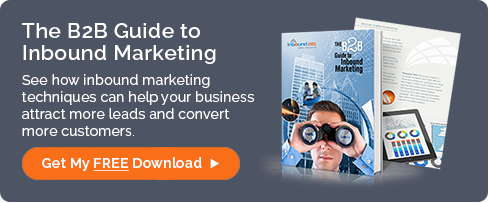How to build an AdWords PPC campaign that works
Building a successful PPC campaign is a bit like walking a very fine line. Get it right, and the returns are fruitful. Get it wrong, and you can find...
14 min read
Mark Parent
September 30, 2016 4:15:51 PM EDT

_600x.jpg)
Julia Payne is an expert in tech growth through marketing and Founding Director of Incisive Edge, one of the leading inbound agencies in the UK.
As we all know, inbound marketing works across industry, but unlike some industries, tech companies have very defined stages of growth with different marketing needs at each stage. They also, necessarily, have a very specific focus on their metrics.
When we are referred into tech companies, typically they will be in one of the following stages:
Problem/Solution fit. At this stage, as tempting as it is for the owners to be distracted by marketing and plow on in, the focus should be on ensuring there is a market need and that their product/service fulfills that need.
Product/Market fit. This is a crucial stage for tech companies and where inbound marketing can really come into its own to drive growth. Emphasis includes value proposition and brand messaging, buyer personas and buyer intent, the addressable market and the diversified marketing plan as part of the overall Channel/Market fit.
Stepping Stone. As growth takes hold, refining the customer experience/onboarding and funnel optimization become vital. At this stage again, inbound marketing plays a key role in ensuring the company not only continues to onboard clients, but retains and delights them.
Growth. During this stage, there is a shift in focus from revenue growth to profitability. Marketing plays the role in aggressive customer acquisition, improving visitor to trial conversion rates through A/B testing and creating an established and repeatable marketing and sales process, ensuring both are aligned. A seamless inbound sales and marketing approach is required.
Maturity. As with every company, tech companies need to retain their competitive edge and during Maturity this becomes an imperative, as does looking for opportunities to grow globally. During this phase, marketing plays a vital role in ensuring their growth continues, but also drives experimentation across channel to continue to build an integrated, strategic approach.
Understanding these stages and the different marketing needs and then being able to relate and relay them to the client is what makes the difference between a highly successful inbound marketing strategy or something that's simply average.
Yes, we were delighted that their commitment to sales and marketing excellence was recognized.
For any company, transitioning away from a marketing strategy that has been entrenched over the years is a very difficult thing and the change required shouldn't be underestimated. Commitment is a word we use a lot with our clients, because marketing is a discipline which requires dedication and constant attention. Gone are the days of a set and forget strategy.
And this was the starting point for our clients.
They really wanted to drive their sales through a renewed strategy and were prepared to change their thinking and their behaviors to achieve it. They embraced the inbound approach with vigor, enthusiasm and a dedication to content creation as their strategy's lynch pin. This paid dividends, not just in terms of recognition, but also conversions, which as we all know is what it's about - the bottom line.
Our client's inbound strategy really worked, but each inbound strategy is - or definitely should be - bespoke to the client and their target audience.
At the center of every strategy, though, are the foundations of truly understanding your audience and solving their needs and pain points through interesting, creative content and content assets, ensuring the website is acting as a conversion machine, constantly nurturing.
There was an interesting discussion on forums recently as to whether there should be a very narrow focus on your audience, i.e. all your content is laser-focused on your audience or whether a broader approach works better. Our view tends towards the latter, placing the buyer persona at the center, but recognizing that they live and work in a wider environment. So starting at the center and working outwards, combining solutions and value-led information.
Marketing is supposed to make you feel good and nobody likes a hard fact-only diet!
 The center of every inbound strategy: Understanding your audience
The center of every inbound strategy: Understanding your audience
and solving their needs and pain points. ![]()
When I started the focus was very, very firmly on the bottom of the marketing and sales funnel - on sales. Everything was about the performance of the sales team.
Over time, that focus continued and probably more so to accommodate the movement away from selling 'products' to selling 'solutions'.
Selling solutions requires a specific sales' skill set as it really does place the client and not the product, at the center of everything. Even after all these years, you can still see many sales teams are overly focused on flogging their wares, but customers are just too savvy to accept that approach nowadays.
As an aside, it's interesting to see that what was called solution selling is now becoming inbound sales, an integrated and aligned approach with inbound marketing.
Slowly, over time, focus started to move up the funnel towards marketing. I remember the very first time that someone told me about this thing called a blog. Apparently, it was going to be the next big thing! That was about 13 years ago. It'll never take off ... .
After that, companies became more accepting of the need for marketing to drive sales, but saw outbound as the way forward. Cold calling, direct mail - all the things we know and love about marketing. We all did it ad infinitum and, to be honest, marketing will always be a blend of inbound and outbound and so it should be, but then, the emphasis was always placed on outbound.
We saw a shift though in companies being prepared to try new things.
The big difference was that because marketing technologies were appearing on the market thick and fast, people were doing stuff, but not understanding how or why this stuff linked together to drive sales. It was trial-and-error for everyone until a pattern emerged. Which fast forwards us to today, where inbound marketing provides the framework for driving results, sales and ROI.
Being able to evolve with all those changes and especially the switch of emphasis from sales to marketing has given me a deep understanding of what really works and why - and it's the why that's more important. More so though, it has driven my passion for marketing. Being able to talk to clients with a deep knowledge of what will really make a difference to them, is the reason that I do what I do. Being able to implement and make that difference is the icing on the cake.
We're a full service inbound marketing agency, so for our clients, it's essential that our whole team understands, subscribes to, is invested in and committed to the inbound methodology. Without that, we would not be able to drive the best results for our clients.
Our inbound marketing training provides the springboard both for delivering the best solution for our clients and also ensuring that our team is highly engaged and integrated internally.
In my Utopian world as a Founding Director, I would like to think that our team work less for their salary and more for the value they deliver to our clients and the fact that they can really make a difference and are valued by us as a company. That starts with our philosophy of the internal development of our team being a foundation stone and in turn, the inbound marketing certifications being part of that development structure.
It also helps to qualify out those who want to join our team. Part of our recruitment process is to ensure that people understand the inbound methodology and are prepared to become qualified. If they're not, then typically they won't be the right cultural fit. In reality therefore, it becomes a self-qualifying process.
The exciting thing about marketing - and especially inbound marketing - is that it is constantly evolving. This means that avenues for development and role growth are constant, whether by becoming a channel expert, a strategist or an account executive. This means that if team members want to take a specific direction in their career, we want to be able to develop them into that role. This ensures that both our agency and our team members can grow and have those continual growth opportunities available to them.
We firmly recognize that as an agency, we're a team. There's no superstars and no rainmakers. Everyone works together to achieve results for our clients.
Peter Drucker said, "the aim of marketing is to make selling unnecessary" and that provides the essence of an integrated strategy.
Prospects go through different stages in their buying and decision-making process. In broad brush terms, at the start of their journey, they are looking for ways in which to solve their problem or meet their need. They then want to learn more about the detail of that solution to ensure it's a best fit for them and only when they are truly satisfied will they engage with the company.
This is what we call the buying journey. In tech, the journey forms 4 key stages: Attract, Convert, Onboard and Retain. A more generic buying journey may look like Attract, Engage, Close, Delight.
The potential buyer requires different things at different stages of their journey.
At the top, they require education and value-led information, which is where content will play an important role. As they move further down their journey, they want detail, which may take the form of product sheets, thought leadership or analysis. Ultimately, they want to know that they are not going to be disappointed, so seek credibility in the form of reviews, testimonials and case studies.
The blend of channels which together form an integrated strategy will be entirely dependent on this buying journey. Where do prospects start their journey and where do they go to build on that information and form their buying decision?
A crucial part of forming an integrated strategy is knowing where the audience live for each stage of the journey. By understanding this, a company can form a truly integrated approach with one channel feeding off the other, pulling the prospect through their journey.
This is a key aspect of inbound marketing. It's a pull strategy, rather than a more traditional outbound, push approach.
I think adopting an integrated strategy has always been a necessity and is not just something that is more prevalent in 2016. However, undoubtedly, times have changed. From the Marketing Mix of the '50s, the 4Ps of the '60s, Positioning in the '70s and onto the emotional marketing of the '90s, 2016 brings a myriad of considerations.
We now have to have regard to consumer empowerment, tribalism and authenticity, brand equity and ROI marketing. Harnessing not just the channels, but the sentiment of consumers into a marketing strategy is the true change.

Understand your target audience and available data to find the perfect mix of
SEO, social media, email marketing, and content creation. ![]()
You have hit the nail on the head when you say "give your prospects exactly what they need."
The mix is entirely dependent on the target market, their needs and their pain points. It's their needs which are, or should be, the dominant factor in any marketing strategy and that is where so many companies make the mistake.
Take, for example, a website. For many companies their site is their primary marketing hub, their showcase and calling card to the outside world. Yet still companies persist in talking about themselves throughout the site, providing a poor user experience across the site and ultimately leaving their prospects thinking 'what's in it for me'.
Typically, these companies will not have looked at their analytics or data for years, persisting in the belief that their site, because it's blue, will attract, convert and retain.
Times have moved on - significantly. Prospects can now educate themselves and before they even speak to a sales representative will know as much, if not more, about what they want than the company.
Before we even begin to consider the strategy for a company, we understand their target audience in depth and what the data is telling us. We also research the competition. What's working, what's not and where are the competitive advantages which will enable our client to gain a larger market share and drive conversions?
The perfect blend of channels within the marketing mix must always, necessarily, be defined by the target audience and research. It should never be guided by whims, intuition, trends, or as we hear in so many cases, what the owner's mate Bob (and Bob never has any marketing experience) thinks the company should be doing.
To really drive conversions requires a mind-set shift, away from selling and firmly towards delivering value.
This value-led approach has to be evident and implicit from the initial conversation through to conversion and can take different forms.
Value is about delivering the solution to the client's needs. Whether that's in the form of freely providing valuable information at the outset, through to going above and beyond in the implementation stages.
I say a mind-set shift because truly providing value means setting aside the bottom line for yourself, your company or in our case, our agency and focusing on what's best for the client.
Every company has to be aware of their resources and their profitability, but to our mind, if the focus is not placed firmly on the client, can you truly deliver the conversions they seek and drive value that places you in the realm of a partner, rather than a provider?
At Incisive Edge, we take the view that we would rather not take on a client, than not deliver results.
And we're prepared to say no.
No to a client where we don't feel there is a best fit and no, when a client is insistent on a channel that we know will not drive the results they seek.
Our clients tell us this is one of the things that sets us apart. Our relentless focus on driving results and to tell the truth, regardless of fear or favor. On this basis we are able to create a strategy that is truly going to drive ROI.
I think becoming established and becoming a thought leader or influencer are two different things.
For example, a company can establish itself through longevity, but can become an influencer without having put in the hard yards of longevity.
Influencers have built large communities because that have established themselves as educators and experts who have the ability to influence the buying decisions and opinions of their target audience.
Whilst social media is a primary influencing channel, it is often the blend of content and content assets influencers produce, cross channel, that distinguishes them.
So in breaking that down to look at how inbound marketing can help a company become an influencer, there are 4 key elements:
1. Expertise. An influencer is typically an expert in their field. Whilst there is a new breed of social media influencers who are followed for their entertainment, at the heart of all influencers is an intrinsic expert.
A company needs to demonstrate its expertise in their specific area and market niche.
2. Authenticity. To build a following, the community has to have belief in that individual for their expertise, credibility and sincerity.
A company must have total belief in what they are doing - otherwise, why bother?
3. Positioning. The definitive book on positioning in a marketing context was written by Jack Trout and Al Reis, The Battle for your Mind. Their definition, which still stands today, is a marketing method for creating the perception of a product, brand or company identity.
Positioning is what you do to the mind of the prospect, not the product.
All influencers are positioned in the mind of their community. A company must align everything they do, say and produce around a clear position and positioning statement.
4. Content. The community wants to be entertained and educated and content is the very foundation block of inbound marketing, harnessing the above 3 elements.
Providing value-led, education, entertaining and informative content is at the heart of inbound marketing.
There's so much - too much - content noise available today. By providing what we call 'cut through' content, you can build your targeted community. Cut through content answers the specific questions your audience has and speaks to them for where they are in their buying and decision-making process. Your audience should feel that your company has their interests (rather than your own) at heart.
And this content needs to be consistent in its quality and frequency. One piece every so often is not going to build a community. You need to continually provide answers to your audience's pain points and needs. A happy by product of this is that Google (and there are other search engines available ... ) loves regular, frequent, value-led content, so your domain authority and search rankings will benefit.
 Just like puppies, inbound marketing is not just for Christmas, it's for life.
Just like puppies, inbound marketing is not just for Christmas, it's for life. ![]()
Just like puppies, inbound marketing is not just for Christmas, it's for life.
It is built on the premise of providing content that your audience values.
In itself, this provides lasting opportunities as valuable content, properly distributed, will be found and shared with others, providing longevity and ensuring you reach a wider audience.
It also means that opportunities can come from unexpected sources or locations, which perhaps are not even part of your marketing strategy. It provides you with a global framework.
Inbound marketing provides a structured framework for all your marketing activities. As you build your content library through your site, blog and resource guides, accordingly, your opportunities multiply.
Your internal resource becomes effectively focused around supplying your audience with untold value, ensuring that your team members know and understand the role they are playing in both your business and your client's. This in turn, makes your recruitment processes easier as you can clearly define the roles you require.
Equally, your team find job satisfaction in delivering value to your clients which aids retention and provides your platform for growth.
Inbound marketing also enables you to achieve scale. Marketing should never be just about one-offs, be they campaigns or e-shots. Consistency and sustainability are two of the cornerstones of scalability, which enables sustained growth.
For business owners, time is the one thing there's never enough of, especially when it comes to marketing.
There are so many calls on the owner, that although a business essential - maybe the business essential, marketing is so easily placed on the back burner, there to be focused on when there's less operational stuff to do and more time.
This tomorrow will be a better day approach typically has two results. No clear marketing strategy is ever created, which leads in turn, to an ad-hoc, channel-led approach. Let's do social, send an e-shot, buy some data etc. To be honest, at some point when starting out, we have all taken that approach. Who has the energy to create a strategy at 11 o/c at night after a day fighting fires?
However, this approach is a false economy, both in the short and longer term.
Whilst it makes the owner feel like they are doing something, it's throwing budget and profitability down the drain. Addressing marketing channels without a strategy and in isolation, will only ever produce limited results, because your target market may not even be on that channel, or your messaging is so generic, your target market cannot see themselves in the picture and assumes it's not for them. This immediately places the company in the millions of 'me too' marketing messages their prospects receive, leaving them to turn to a competitor who is specifically addressing their needs and pain points.
Inbound marketing provides an integrated approach to marketing.
Moreover, once the strategy has been created, the owner and their team has a blueprint to follow. All of their marketing and messaging will speak directly to their target audience so there's no wastage in time, resource or budget. Everyone is clear on what the fundamentals of the strategy are - buyer persona, content, engagement across the channels where their audience live, delighting their audience etc., so their team can continually plan, test, learn and revise. It removes the 'project based' element of marketing that so many companies follow and provides a proven formula to follow. This eliminates the continual need for the owner to come up with marketing ideas.
If the owner needs help in formulating or implementing the strategy, our recommendation would be to seek an agency that not only understands your business and objectives, but truly understands the industry as well. A one-size-fits-all strategy will not produce the same results as a focused, industry-specific strategy.
The agency needs to really understand the client's target market and that extends far beyond pure demographics. Behavioural and psychographic understanding of the target audience is essential to produce value-led content - it's those nuances that make the difference.
Above all, for an owner, where their business is their life, their baby and their hopes for the future, engaging an agency where they care about producing results as much as the owner is essential. An agency that looks beyond their own profit margin to that of their customer, is worth their weight in gold.
Finding such an agency will enable the owner to rest easy, safe in the knowledge that their marketing is truly going to be a reflection of their brand and will drive the growth of their business.
Ultimately, your marketing agency should be your partner - invested in your business as much as you are.
Want to see how organizations that operate in B2B industries can use inbound marketing to increase leads and sales goals? Get your free copy of our B2B Guide to Inbound Marketing.

Make sure to connect with us on LinkedIn to get valuable insight on the latest news in marketing and website design. Follow us here:

Building a successful PPC campaign is a bit like walking a very fine line. Get it right, and the returns are fruitful. Get it wrong, and you can find...

The Celts are well-known for their intricate and decorative knot work. Though individual Celtic knots have a variety of meanings, their symbolism...

Southeast Michigan aficionados of the inbound marketing platform HubSpot have reason to rejoice: there is once again a local user’s group for...